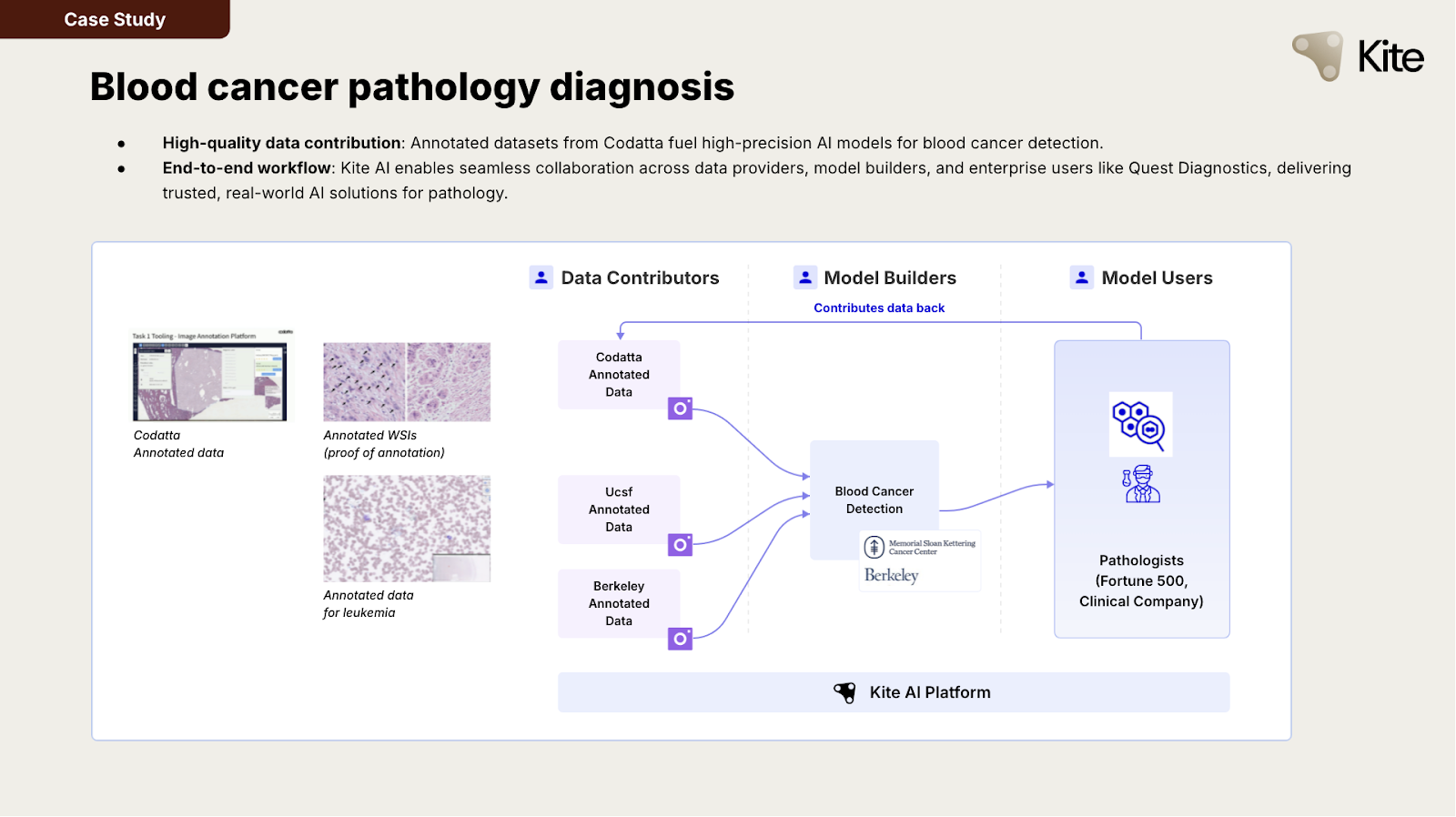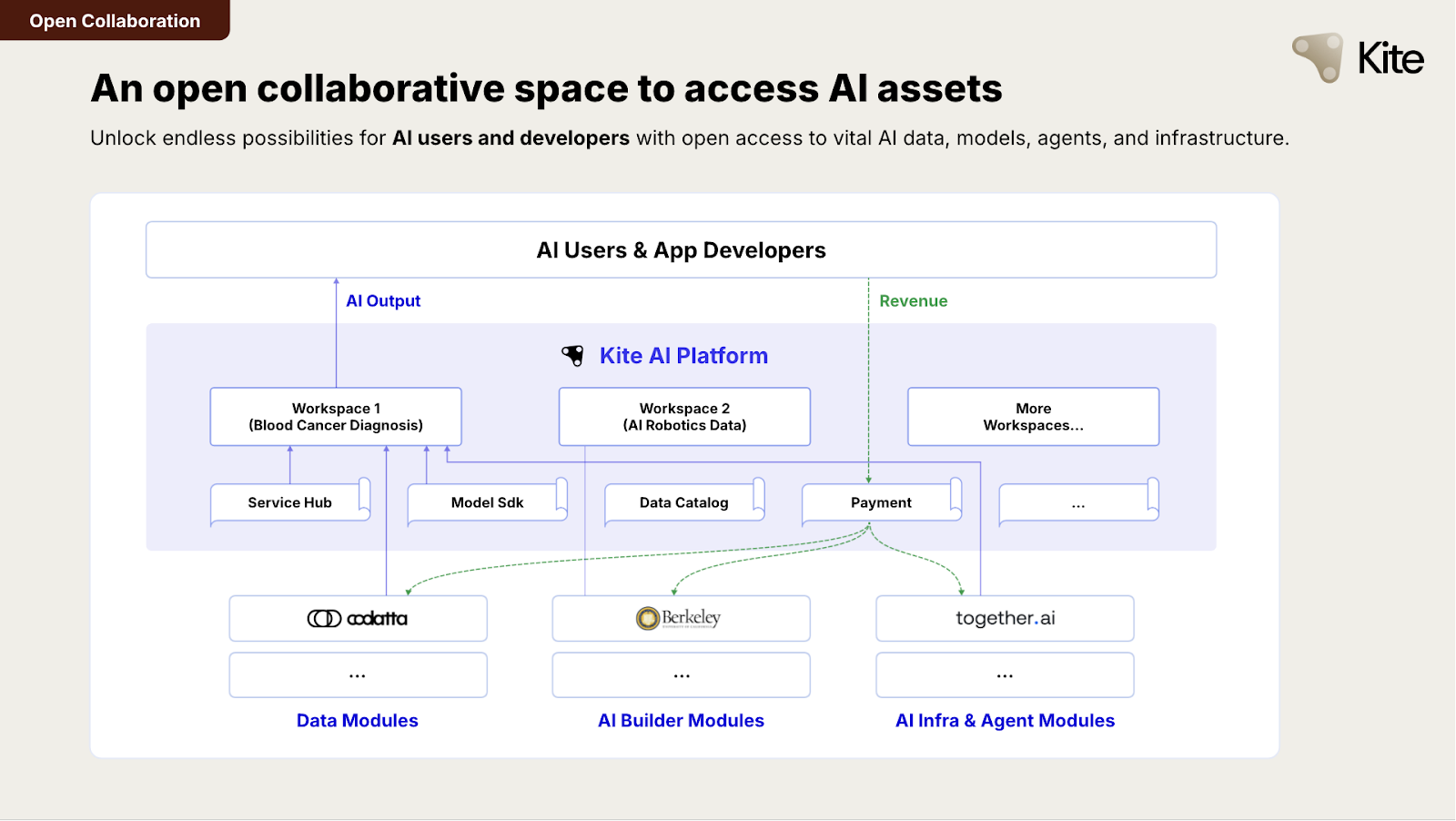Kite is building the next generation AI foundational trading layer, aimed at creating network effects by providing real utility within a decentralized AI economy. At its core is a trust layer—an open decentralized network where autonomous modules can operate with complete interoperability and verifiability. Kite's token economic model is designed to incentivize both the supply and demand of agent services. Kite's modular and composable design provides a unified infrastructure for identity, payments, and governance, enabling agents to securely authenticate, transact, and collaborate without any intermediaries.
In this article, we will explore how Kite's design creates an ecosystem of value accumulation, and how early ecosystem incubation projects like Codatta demonstrate measurable success within this ecosystem.
Codatta (Kite's Data Module): Demonstrating Real Utility
Codatta is a decentralized data protocol that provides verified high-quality datasets for AI applications. Codatta is the next generation data marketplace, fully on-chain and integrated into Kite's trust layer. Codatta focuses on curating datasets in fields such as healthcare, health, and embodied intelligence, where data quality and provenance are crucial. Each dataset includes verifiable metadata, traceability, and a built-in royalty mechanism for contributors.
Codatta exemplifies Kite's technology as it leverages Kite's network's collaboration and identity features to control and track data access. Accessing data requires verifiable credentials (such as Kite's identity passport) to ensure that sensitive information, like patient health records, is only used by verified agents and under specific conditions, which can be programmed through Kite's smart contracts. Each access or computation is recorded on-chain, creating an audit trail for data lineage and usage. This traceability is vital in industries like healthcare, where compliance and trust depend on proof of data usage.

As Kite's first data module, Codatta demonstrates how supply and demand connect on the platform. On the supply side, Codatta provides valuable resources (datasets); on the demand side, there may be AI diagnostic applications or robotic simulations that require these datasets to operate. Through Kite, both sides connect seamlessly: agents can query data without trust and with permission, pay for this high-quality data, and receive cryptographic guarantees of data integrity. Data providers can receive automatic payments and retain governance rights, all enforced by Kite's collaborative logic.
Codatta's early success validates Kite's ecological model. During its incubation phase, Codatta also received joint funding from Kite and the Avalanche Foundation's InfraBUIDL(AI) program—a $15 million funding initiative aimed at accelerating innovation at the intersection of AI and decentralized infrastructure. This funding not only provided Codatta with critical resources but also connected it to Kite's broader ecosystem, accelerating the pace of technology deployment and ecological collaboration. With this support, Codatta achieved several key milestones, such as launching the first autonomous medical data labeling workflow—combining blockchain's auditability with AI's problem-solving capabilities, highlighting the strong market demand for high-value AI assets.
Note: In 2025, Codatta also achieved significant results in community building and market expansion through deep collaboration with Binance, including Pre-TGE, a 12-week Booster program, and launching on Binance Alpha and perpetual contract markets. See: Binance Announcement
Network Flywheel: Building a Sustainable AI Ecosystem

Kite combines results-oriented design, modular architecture, aligned incentive mechanisms, innovative token economic models, and real-world utility (such as the Codatta module) to create a self-driven growth flywheel. Its mechanisms are as follows:
- Module-Driven Adoption: New modules, such as data providers (like Codatta), computing power services, or AI microservices, will introduce new communities and real use cases, thereby enhancing on-chain activity.
- Adoption Volume Enhances Underlying Value: Increased activity raises demand for Kite resources, creating transaction fees and rewards for validators, enhancing the network's security and decentralization, thus attracting more enterprise and institutional participants.
- Strengthened Value Capture: As modules can collaborate, value can flow freely between different modules, creating a flywheel effect that stimulates continuous value creation. Kite's economic system can capture the value of these overall activities and reward participants and contributors.
This flywheel emphasizes the composability and interoperability between modules, avoiding the value fragmentation caused by "siloed services." Each successful module is based on actual outcomes rather than conceptual hype, and the "Protocol-to-Protocol" token model ensures that incentives remain aligned around practical value and long-term participation.
Why Kite is the Infrastructure for the Next Generation Decentralized AI Economy
Beyond Block Space, Focusing on Real Outcomes: Rethinking Layer 1 Value through Real Utility
Most blockchains commercialize their block space through transaction volume, often favoring speculative and short-term behaviors. In contrast, Kite focuses on "actual outcomes," organizing AI workflows through a programmable coordination layer, where the unit of value measurement is "whether the task was successfully completed using verifiable data." For example, a reliable diagnosis completed by an AI medical diagnostic system is a manifestation of value. Kite promotes not virtual prosperity, but actual output.
Modular, Composable, and EVM-Compatible Architecture Design
Kite's most significant advantage lies in its modularity and composability. Unlike "monolithic chains" or isolated subchain structures, Kite is a network composed of multiple modules that connect through a shared coordination layer. Kite is fully EVM-compatible and designed for cross-chain interoperability, allowing seamless integration with existing Web 3 ecosystems.
This coordination layer unifies three key functions: "verifiable identity," "rule execution," and "on-chain settlement," enabling secure collaboration between modules and facilitating trustworthy exchanges of data and value, allowing the entire system to operate efficiently without intermediaries. This design avoids the "value trap" of traditional fragmented ecosystems, where all modules share the same incentive logic, and value flows freely within the network. Each new module enhances the overall utility of the network, driving more usage and creating a growth flywheel.
Progressive Decentralization and Aligned Incentive Mechanisms
Kite adopts a strategy of progressive decentralization, initially leveraging the I’m framework of Avalanche to establish a large pool of validators and gradually delegating governance to the community. At the same time, Kite's Proof of Artificial Intelligence (PoAI) mechanism and contribution tracking system reward based on outcomes, incentivizing collaboration among all stakeholders, from developers to data providers, thereby reducing noise and establishing a collaborative AI ecosystem.
Ecological Alignment
Kite employs a "protocol-to-protocol" reward distribution mechanism, prioritizing builders, modules, and partners as incentive targets, linking rewards to actual performance. By implementing on-chain rules for transparency, it ensures that rewards are directly associated with valuable contributions (such as data validation or data governance). Additionally, Kite provides extra value through staking rewards and long-term utility, creating a positive feedback loop: the success of modules drives the increase in network value.
Kite is based on a new collaborative paradigm that eliminates information silos, ensuring that the incentives of all participants in the network remain aligned. Projects like Codatta are addressing real problems, such as building trustworthy medical AI processes and providing verified and secure data. The success metrics for Kite are the impacts each module generates in real-world applications, such as improving diagnostic levels and accelerating medical research. Kite's economic system builds a community of builders who come together through shared ownership and governance mechanisms.
Replacing "Throughput-Oriented" with "Outcome-Oriented"
By focusing on outcomes rather than throughput, Kite challenges the traditional Layer 1 paradigm. Networks based on "traditional subnetworks" or lacking programmability and modular architecture have already shown their limitations: resource fragmentation and a lack of a unified coordination layer, leading to value being trapped in scattered corners and stagnation of network effects.
In Kite's network economy, every participant, from AI scientists to data contributors to ordinary participants, operates within a shared network with clear and fair rules. The result is an environment where innovation is no longer limited by technical silos or misaligned incentives.
We have already seen projects like Codatta leveraging Kite to solve real problems (such as trustworthy medical AI data pipelines), and more modules will soon be released, ranging from AI agents and AI models to data and AI infrastructure, all operating on Kite's underlying infrastructure. Each module contributes to Kite's vision: to build a decentralized, modular network where agents and services can easily discover each other, exchange value, build trust, and co-evolve.
Kite's Success Metrics: Going Beyond Traditional Crypto Metrics, Focusing on Real Value
The success of the Kite ecosystem will not only be measured by traditional on-chain metrics but will also be comprehensively evaluated based on the value created and the business impact generated by AI-driven applications on its network. The value of the Kite ecosystem will stem from efficient workflows and a community composed of developers and AI users—united by their shared interests in a collectively owned and governed decentralized AI ecosystem.
免责声明:本文章仅代表作者个人观点,不代表本平台的立场和观点。本文章仅供信息分享,不构成对任何人的任何投资建议。用户与作者之间的任何争议,与本平台无关。如网页中刊载的文章或图片涉及侵权,请提供相关的权利证明和身份证明发送邮件到support@aicoin.com,本平台相关工作人员将会进行核查。




